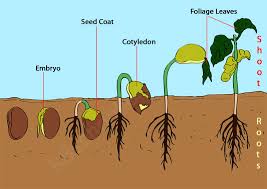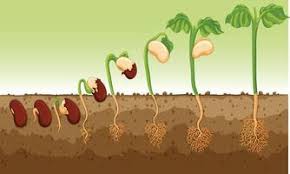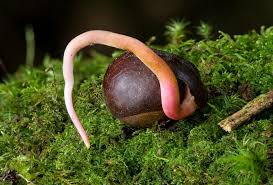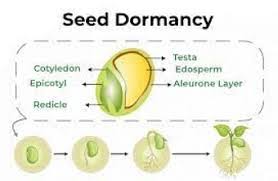With seeds, the independence of the next generation of plants begins. Seeds must germinate and become established to produce the next set of seeds. Nature allows different periods for seeds to initiate the germination process.
The failure of an intact viable seed to complete germination under favorable conditions is referred to as dormancy. These two critical phenomena seed dormancy and germination are controlled by factors that will be discussed in this article.
Read Also: Mushroom Growing Kits
Seed Germination Process

Every seed contains an embryo, which is the new plant in miniature. It is structurally and physiologically equipped for its role, as it is well-provided with enough food reserves to sustain the growing seedling until it establishes itself as a self-sufficient, autotrophic organism.
Germination begins with the uptake of water by the dry seed (imbibition) and is completed when a part of the embryo, usually the radicle, extends to penetrate the structures surrounding it. Uptake of water by a mature dry seed occurs in three phases.
Phase one involves a rapid initial uptake followed by a plateau phase (phase two). The third phase takes place with further uptake of water after germination is completed, as the embryonic axes elongate. Dormant seeds do not complete germination and, therefore, cannot enter phase three.
The influx of water into the cells of dry seeds during phase one causes temporary structural changes, particularly to membranes, which result in rapid leakage of solutes and low molecular weight metabolites into the surrounding imbibition solution.
Upon imbibition, the quiescent dry seed resumes metabolic activity. The structures and enzymes necessary for this initial resumption of metabolic activity are assumed to be present within the dry seed, having survived, at least partially intact, the desiccation phase that terminates seed maturation.
Reintroduction of water during imbibition is sufficient for metabolic activities to resume, with turnover or replacement of components occurring over several hours until full metabolic status is achieved.
The time for these events to be completed varies from several hours to many weeks, depending on the plant species and germination conditions. With few exceptions, the extension of the radicle through the surrounding structures marks the end of germination and the beginning of seedling growth.
Conditions Required for Seed Germination

Several factors influence seed germination, including:
- External factors such as water, oxygen, and suitable temperature.
- Internal factors such as seed dormancy due to internal conditions.
Water is crucial to seed germination. A dormant seed is generally dehydrated and contains only about 6-15% water in its living cells. However, the active cells require approximately 75-95% water to carry out their metabolism.
Therefore, dormant seeds must absorb external water to become active and undergo germination. In addition to providing hydration for the protoplasm’s vital activities, water softens seed coats, causes their rupture, increases seed permeability, and converts insoluble food into a soluble form for its translocation to the embryo.
Water also brings in the dissolved oxygen needed for the growing embryo. The seed must go through imbibition to activate root growth. However, excessive water can harm a germinating seed.
When a plant is growing underground during root formation, it relies on stored food inside the seed and oxygen from the environment to produce energy. If the soil is too saturated with water, there may not be enough oxygen for the plant to survive.
Temperature is another important factor. Moderate warmth is necessary for the vital activities of protoplasm. Some seeds germinate in cold conditions, while others only germinate in warmer temperatures.
Other seeds germinate only after extreme temperatures, such as after a fire in grasslands. Although germination can occur within a wide temperature range (5-40°C), the optimum for most crop plants is around 25-30°C. Germination generally ceases at temperatures of 0°C and 45°C.
Oxygen is necessary for respiration, which releases energy needed for growth. Germinating seeds respire actively and require sufficient oxygen. The oxygen is obtained from the air within the soil.
For this reason, seeds sown too deep or in waterlogged soils (which are oxygen-deficient) often fail to germinate due to insufficient oxygen. Cultural methods such as ploughing and hoeing aerate the soil and facilitate good germination.
Read Also: Mushroom farming at home
Seed Dormancy

Seed dormancy is generally an undesirable characteristic in agricultural crops, where rapid germination and growth are required. However, some degree of dormancy is advantageous, particularly during seed development.
This is especially true for cereal crops, as it prevents pre-harvest sprouting, which can lead to significant losses. Thus, dormancy is an adaptive trait that optimizes the distribution of germination over time in a population of seeds.
Crop species have generally eliminated most dormancy mechanisms present in their wild ancestors, although dormancy may reappear under adverse environmental conditions.
In contrast, weed seeds often mature with inherent dormancy mechanisms, allowing some seeds to persist in the soil for many years before completing germination.
Nearly all cellular and metabolic events that occur before the completion of germination in non-dormant seeds also occur in imbibed dormant seeds. However, for some unknown reason, the embryonic axis (i.e., the radicle) of a dormant seed fails to elongate.
What is Dormancy?
Although many researchers study dormancy, there is no universally agreed-upon definition, as it manifests differently in various species. For simplicity, seed dormancy is regarded as the failure of an intact viable seed to complete germination under favorable conditions.
In some species, the embryo is constrained by surrounding structures, preventing germination. This phenomenon is known as coat-enhanced dormancy; embryos isolated from these seeds are not dormant.
In other species, embryos themselves are dormant (embryo dormancy). Dormancy is regulated during different developmental phases in interaction with environmental factors, making it difficult to pinpoint when genetic and physiological differences are established.
Importance of Seed Dormancy
Seed dormancy provides several advantages in agriculture, including:
1. Perennation: Dormancy allows seeds to survive adverse conditions such as drought and cold.
2. Dispersal: Dormancy is essential for seed dispersal, as it allows seeds to be distributed across different locations, aiding in the natural distribution process.
3. Germination under favorable conditions: Dormant seeds only germinate when sufficient water is available to remove inhibitors and soften seed coats. This process prolongs seed viability under unfavorable conditions.
4. Storage: Dormancy enables humans to store grains, pulses, and other edibles, making them available year-round and transportable to areas with shortages or better prices.
Breaking of Seed Dormancy
There are two types of seed dormancy breaking: natural and artificial. In nature, seed dormancy is broken due to:
- Development of growth hormones to counteract growth inhibitors.
- Leaching of germination inhibitors.
- Maturation and after-ripening of the embryo.
- Weakening of tough, impermeable seed coats by microbial action, abrasion, or passage through the digestive tract of animals.
Artificial Breaking of Seed Dormancy
This involves;
1. Scarification: Weakening or rupturing hard, impermeable seed coats through filing, chipping, hot water, or chemical treatments.
2. Stratification: Moistened seeds are exposed to oxygen at low or high temperatures for varying periods. Mechanical stratification can also be used, such as with sandpaper, a hammer, or a knife.
3. Counteracting Inhibitors: Inhibitors can be destroyed by treating seeds with KNO3, thiourea, ethylene chlorohydrin, or gibberellin.
4. Shaking and Pressure: Vigorous shaking and hydraulic pressure are used to weaken seed coats.
With seeds, the independence of the next generation of plants begins. Although seed dormancy may seem counterintuitive to seed function, it prevents premature germination.
Dormancy is generally undesirable in agricultural crops, where rapid germination is required. However, some degree of dormancy is beneficial during seed development.
In this article, we have explained the processes involved in seed germination, the factors that affect it, and the concept of seed dormancy.
We have also examined the causes of dormancy, its importance in agriculture and food security, and methods for breaking dormancy or reducing the dormancy period in seeds.
Do you have any questions, suggestions, or contributions? If so, please feel free to use the comment box below to share your thoughts. We also encourage you to kindly share this information with others who might benefit from it. Since we can’t reach everyone at once, we truly appreciate your help in spreading the word. Thank you so much for your support and for sharing!

